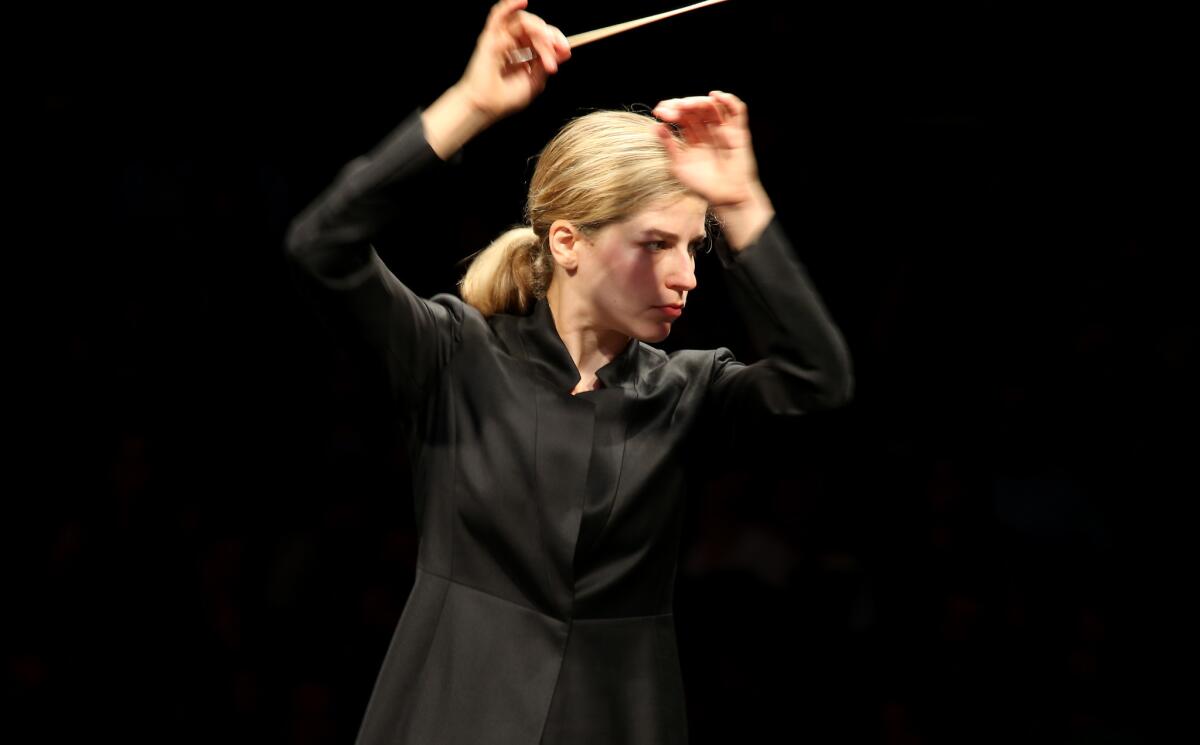Review: Why Bernstein’s ‘The Age of Anxiety’ was a bold choice for Karina Canellakis and Jean-Yves Thibaudet at the Bowl

- Share via
The exact date of Leonard Bernstein’s 100th birthday was celebrated all over the world on Aug. 25; even Google got into the act with a marvelous Google Doodle cartoon. The Los Angeles Philharmonic, however, had other plans. The orchestra did its big, all-Bernstein salute at the Hollywood Bowl on July 10, and when the milestone date arrived, the schedule had the orchestra busy playing Tchaikovsky.
But there was one more significant Bernstein commemoration to come at the Bowl, and that occurred better late than never on Tuesday night when Karina Canellakis came to conduct, and Jean-Yves Thibaudet came to play, Bernstein’s Symphony No. 2 (1949) whose subtitle is “The Age of Anxiety.”
It was worth the wait.
The piece is a meditation on W.H. Auden’s book-length poem of the same name, although some of its ingredients were raided — Bernstein’s lifelong habit — from earlier songs, sketches and such. It’s really a de facto piano concerto, divided into sections whose titles mirror those in the Auden poem. It’s also a self-portrait of Bernstein himself, concerned with what he perceived as the crisis of faith in the 20th century, always eager to make a grandiose statement. And yes, the Bernstein who loved to party is here too, in the great super-jazzy scherzo, “The Masque,” which was often played on its own by an early advocate, composer and pianist Lukas Foss.
Bernstein set a very high bar for future performers, leaving at least six released recordings of the symphony — four on audio, two on video — for them to chew on. Canellakis leaped over that bar with an electrifying performance, establishing the brooding mood early on, heating up the momentum in “The Seven Stages” section, keeping the rhythms sharp, bringing the Epilogue to a grand, satisfying close. Thibaudet, an old hand at “The Age of Anxiety,” handled the piano parts with rhapsodic freedom and a sure rhythmic hand; only in “The Masque” were there some odd highlightings of certain lines that disrupted the swing a bit.
It will be interesting to see which of Bernstein’s once-underrated concert works will remain in the repertoire permanently after the centennial is over and done with. But a performance like this makes the case that “The Age of Anxiety” will be one of them.
Unlike Canellakis’ Bowl debut in a safe, all-Mendelssohn program last summer, “The Age of Anxiety” was a bold choice, as the old amphitheater isn’t quite used to the dissonances — some derived from the 12-tone method — that the young Bernstein was experimenting with. There was more enterprise at the outset with “A Short Piece for Orchestra” by the prolific yet unheralded African American composer Julia Perry (1924-79), which starts out sassily and vacillates between contemplation and energetic high jinks in the mid-20th-century American neoclassical idiom.
Finally came Brahms’ Symphony No. 2 — not an original conception but well-organized and put forth with conviction. Again, Canellakis demonstrated a graceful baton technique and musicality that was reflected in the playing of the Philharmonic. The Netherlands Radio Philharmonic recently signed her on as its new chief conductor, starting in 2019, and that orchestra is lucky to have her.
More to Read
The biggest entertainment stories
Get our big stories about Hollywood, film, television, music, arts, culture and more right in your inbox as soon as they publish.
You may occasionally receive promotional content from the Los Angeles Times.










